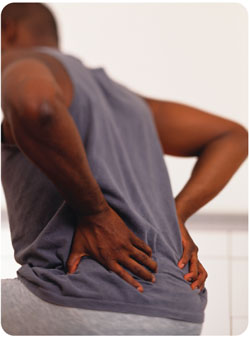 Sometimes called a slipped or ruptured disk, a herniated disk most often occurs in your lower back. It is one of the most common causes of low back pain, as well as leg pain. Although a herniated disk can sometimes be very painful, most people feel much better with just a few weeks or months of nonsurgical treatment.
Sometimes called a slipped or ruptured disk, a herniated disk most often occurs in your lower back. It is one of the most common causes of low back pain, as well as leg pain. Although a herniated disk can sometimes be very painful, most people feel much better with just a few weeks or months of nonsurgical treatment.
Disks are soft cushions between the vertebral bones of the spinal column. They allow the spine to flex, bend and twist. A disk begins to herniate when its jelly-like center pushes against its outer ring due to wear and tear or a sudden injury. This pressure against the outer ring may cause lower back pain.
If the disk is very worn or injured, the jelly-like center may squeeze all the way through.
Once the center pushes through —or herniates— through the outer ring, pain in the lower back may improve. Sciatic leg pain, however, increases. This is because the jelly-like material inflames the spinal nerves. It may also put pressure on these sensitive spinal nerves, causing pain, numb-ness, or weakness in one or both legs.
In addition to the gradual wear and tear that comes with aging, other factors can increase the likelihood of a herniated disk. Using your back muscles to lift heavy objects, instead of your legs, can cause a herniated disk. Lifting with your legs, not your back, may protect your spine. Being over-weight puts added stress on the disks in your lower back.
Repetitive activities may strain your spine. Regular exercise is important in preventing many medical conditions, including a herniated disk. It is also believed that smoking lessens oxygen supply to the disk and causes more rapid degeneration.
Symptoms may be one or all of the following:
- Back pain
- Leg and/or foot pain (sciatica)
- Numbness or a tingling sensation in the leg and/or foot
- Weakness in the leg and /or foot
- Loss of bladder or bowel control (extremely rare)
To determine whether you have a herniated lumbar disk, your doctor will ask you for a complete medical history and conduct a physical examination. The diagnosis can be con-firmed by a magnetic resonance imaging (MRI) scan.
In the majority of cases, a herniated lumbar disk will slowly improve over a period of several days to weeks. Typically, most patients are free of symptoms by 3 to 4 months. However, some patients do experience episodes of pain during their recovery.
Unless there are neurological deficits, conservative care is the first course of treatment and includes rest, anti-inflammatory medications, physical therapy and epidural steroid injections.
Only a small percentage of patients with lumbar disk herniations require surgery. Spine surgery is typically recommended only after a period of nonsurgical treatment has not relieved painful symptoms. The most common surgical procedure for a herniated disk in the lower back is a lumbar microdiskectomy. Microdisketomy involves removing the herniated part of the disk and any fragments that are putting pressure on the spinal nerve. The results of microdiskectomy surgery are generally very good.
The Orthopaedic Clinic has a dedicated Spine Clinic for evaluation of back and neck problems. We offer extensive non-surgical treatment for spinal issues including herniated disks and, when the need arises, have a fellowship-trained spinal surgeon with expertise in the surgical treatment of spinal disorders.
